
遊亀 祇園店
Yuuki
3.56
Gion, Kiyomizu-dera, Higashiyama
「Izakaya (Tavern)」
4,000-4,999円
--
Opening hours: [Monday-Friday 16:00-21:30 [Saturday] 15:00-22:00
Rest time: Sundays and holidays Business hours and holidays are subject to change, so please check with the store before visiting.
京都府京都市東山区富永町111-1
Photos
(20)


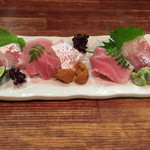

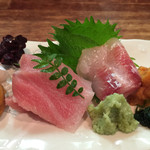








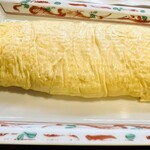






Details
Reservation Info
Reservations possible Reservations can be made for two people.
Payment Method
Cards accepted
(AMEX, JCB)
Electronic money accepted
Private Dining Rooms
None
Smoking and Non-Smoking
No smoking at the table
Parking
None
Facilities
Counter seating available, tatami room available
Drink
Sake available, shochu available, focus on sake
Dishes
Focus on fish dishes
Comments
(16)
あかかもめ
4.70
Every time I go up to Kyoto with the bees, I always make sure to visit the restaurant "Gion Yukame." Except for last year's late autumn visit that was canceled due to an accident, I've pretty much been here every time. I usually consider it the main event on the day before the final day, so it's a must-visit to end the day. I arrived at the location near the entrance around 8 pm after moving from the nearest bus stop to Shijo Keihan Station. As I expected, I was able to sit down without waiting because the counter seats near the entrance were available. I quickly looked at the menu and noticed a limited summer sake, so I ordered a glass right away. I enjoyed the summer sake, which was refreshing and dry. I liked it. I started with the simmered eggs and broccoli. The seasoning was not too strong, and it was delicious. It went well with the sake. I also ordered a plain rolled omelet. The dashi flavor soaked in gently, making it a perfect rolled omelet. I couldn't resist it. I also ordered corn tempura. The sweetness of the corn combined with the crispy batter was incredibly delicious. Along with the rolled omelet, this is a must-order dish when you come here. I think I also ordered cheese tempura, but I didn't take notes, so I can't be sure. I remember it was delicious. Of course, I needed more sake, so I ordered cloudy sake. It had a hint of koji flavor and was delicious. I ordered another glass of summer sake. I also ordered the katsu soup, which I was impressed by last time. The flavor of the koji and miso was exquisite. It made me feel like I could drink as much sake as I wanted. It was the last order, but I was already quite full, so I decided to stop here. Ah, no matter how many times I come here, it's always a wonderful restaurant.




rebir721
3.50
I arrived after 5 p.m. and it was fully booked. We had to wait for two people ahead of us to be seated. One of the attractions is that you can choose original local sake with a rice polishing ratio of 20% to brown rice. The rice itself may not be that tasty, but it's nice to be able to drink according to your preference. There are many appetizer menu options, but the dashimaki tamago (rolled omelette) is excellent. The other appetizers were also delicious.


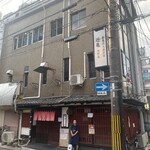
sakur776
3.80
Now, let's talk about Kyoto. This time, I attended a private party. Usually, it's on Saturdays, but this time it was on a Friday. We decided to make a surprise visit to a popular izakaya. Luckily, there was just enough space for us. It's amazing how popular it is, even though it's not even 5:00 pm yet. We ordered the mixed nanban pickles, draft beer, and the long-life turtle blue 90. The nanban pickles were incredibly delicious. I am completely satisfied.




enurinri
3.50
We made a reservation for 5 people at 19:00 (the last available time) and visited the restaurant. We ordered: grilled conger eel, whale cheek sashimi, assorted sashimi platter (5 kinds), conger eel roe salted fish, grilled duck breast, fried horse mackerel, corn tempura, spicy cod roe rolled omelette, and mackerel sushi. As always, everything we ordered was consistently delicious.




るちた
4.50
The sashimi, eel, and grilled dishes were all incredibly delicious, but the most impressive part was the sake. I was taken there by a university professor, and even as a student, I felt like I could afford it if I just ordered a few small dishes. The staff were very kind, they made room for us and recommended some sake for us. It was a very enjoyable experience.
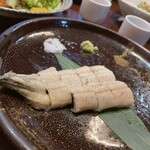

darkn
4.00
Yuuki Gion Shijo
⏰ [Mon-Fri] 4:00 PM - 9:30 PM
[Sat] 3:00 PM - 10:00 PM
First visit to Yuuki Gion and it was great! It was almost full in the 4 o'clock hour. Every dish was delicious, the staff was friendly, and I was very satisfied. The rock oysters were especially delicious.
#Yuuki #GionShijo #GionShijoGourmet #Izakaya #Seafood #FishDishes #RockOysters #Kyoto #Delicious #Yummy #Seafood #Oyster #Instagood #Instalike #Instapic #Instafood #Foodporn #Foodstagram #Foodie #Foodphotography #Foodpics #Followme




ヒノメシ
4.00
Yugame Gion store was a wonderful dining experience. Here are my thoughts on some of the dishes:
- Octopus Tempura: Juicy and very delicious. The combination of the texture of the octopus and the crispy coating was exquisite.
- Fried Horse Mackerel: The fresh taste of the homemade tartar sauce stood out. The way the horse mackerel was fried was perfect, making it a very tasty dish.
- Assorted Sashimi: The selection of fish was superb, with fatty fish included. I was able to enjoy fresh and delicious sashimi.
- Garlic Shrimp: The shrimp wrapped in crispy coating matched perfectly with the flavor of garlic. It was a very delicious dish.
The dishes at Yugame Gion store were all excellent, showcasing the discernment and skills of the restaurant. I would like to visit again.




マリント
4.00
In Gion, I was looking for a pub to enter but couldn't decide on one. As a sake lover, I was intrigued by a "brewery-owned store". There was a man outside calling out to customers, and after passing by once and returning, I decided to enter as the place seemed highly recommended. Even though we weren't planning to stay long, the man and his two friends recommended some sake for us to try. The variety of sake was perfect, as expected from a direct store. Although I wanted to drink more, I had already eaten a lot for lunch so I ended up with just three cups. The food was all delicious. I hope to come back again and try all the different types of sake next time.



sarutobisasuke
3.50
The bars in Gion have a traditional atmosphere, like a ryotei where maiko come, and most of them are high-end and intimidating to enter. However, this place has an old-fashioned feel but is relatively easy for common people to enter. The menu is extensive, with both typical dishes and Kyoto-style options. I tried the mentaiko tamagoyaki, which was unique and surprisingly delicious. The prices are also affordable.




7070JAZZ
3.80
Tonight, I visited a long-awaited izakaya in Gion. This place is a casual izakaya that mainly serves the main brand "Kanemaru" from the Japanese sake brewery "Okamura Honke" in Shiga Prefecture. They offer fresh fish from the Kyoto Central Wholesale Market, seasonal Kyoto vegetables, and meat dishes to enjoy with sake. Unfortunately, I'm not a fan of sake (^^;) There were already two couples waiting in front of the restaurant, and even foreign visitors were hesitating whether to line up or try another restaurant. Oh, a beautiful geisha just passed by quickly in front of me ♡ After waiting for about 30 minutes, I finally entered the restaurant, where a few customers were waiting at the counter. I started with a draft beer. - Sashimi Assortment (3 types) - Today's sashimi menu was limited, so I chose fresh octopus, medium fatty tuna, and yellowtail. - Horse Mackerel Fry - The thick and hot horse mackerel fry was delicious. I'll have a highball next. - White Shrimp Tempura - The hot and crispy white shrimp tempura was delicious. - Rolled Omelette - The hot and speedy rolled omelette arrived after ordering. - Fish Head Soup - A flavorful red miso soup with plenty of fish head. It's been a while since I enjoyed a night in Gion, and it's nice to see the lively atmosphere returning. However, there were also foreign visitors wandering around without masks. I might leave early. Thank you for the meal.




あ わ
3.50
This is a izakaya in the Gion area of Kyoto. We stopped by for a drink as our second stop after having a drink elsewhere. The exterior has a cool, traditional look and the interior is cozy with an old-fashioned feel. We were seated on the second floor and ordered some sake. They had a wide variety of Shiga sake from the same brand, Okamura Honke's Kaname. I decided to try the chilled version. We also ordered some food: - Fried shrimp and taro: 780 yen - Sweet and spicy bell pepper stir-fry: 700 yen - Deep-fried fresh wheat gluten: 700 yen - Horse mackerel fry: 500 yen (forgot to take a photo) Apart from the horse mackerel fry, the dishes had a Kyoto-style touch. The food was delicious, especially the fried shrimp and taro which had a subtle flavor. I love fried taro, so I was very satisfied. The bell pepper stir-fry was simple and tasty, with a nice balance of bitterness and sweetness that paired well with the sake. The fresh wheat gluten absorbed the broth well and had a good texture, also complementing the sake. We enjoyed the meal with some sake, and I even ordered some fresh sake when we ran out. Overall, it was a delicious experience. I wish there was an izakaya like this in my neighborhood. Thank you for the meal.




ken1tnk1958
3.30
Okamura Honke (established in 1854), a sake brewery in Toyono, Shiga Prefecture, operates a direct sales store. The store sign reads "Kin Kame Brewery Direct Sales Store" as the brand "Kin Kame" is more recognizable, but the operation is run by Kin Kame, Oshimaru Honke (located in Yoshida, Toyosato-cho, Inugami-gun, Shiga Prefecture). The name "Kin Kame" is derived from the alias of the Ii family's Hikone Castle, known as "Kin Kame Castle." Located on a street that may be unfamiliar to even Kyoto residents, but easily recognizable as "Gion Shijo" by anyone, the store is situated at the corner of the first street, "Tominaga-cho Dori," when turning left at the famous "Kiridoshi" before Hanamikoji on the way from Gion Shijo Station to Yasaka Shrine. It takes about 4-5 minutes on foot from the station. As I spent my student days in Kyoto in the late 1970s, the name "Shijo Keihan" feels more natural to me than "Gion Shijo Station." On this winter weekday, I chose to stay at a reasonably priced national chain hotel in Gion for dinner, near the hotel. Although I spent my student days in Kyoto, Gion was not a place I frequented, except for a few occasions. The bustling, lively atmosphere of the store made me imagine it would be crowded, but to my surprise, a single seat at the counter was available. Amidst the hustle and bustle, the moment I sat down, I was able to immerse myself in my own world. The menu reflects a dedication to sake, typical of a sake brewery direct sales store in Shiga. From polishing rates of 0% to 80% in 10% increments, there are options for fire heating and raw sake types, as well as temperature zones for warm, room temperature, and chilled sake, with the choice of tokkuri and glass sizes. Despite the variety, I opted for a draft beer. The food is reasonably priced, with offerings such as Isa Za, Moroko, Nara pickles soaked in Kin Kame sake lees, local Kyoto vegetables, Kyoto-style fried wheat gluten, ham cutlets, and rare delicacies such as "hoya no konowata" and "mackerel heshiko." However, I always order the "sashimi platter." There are options for a 3-kind platter for 1,400 yen and a 5-kind platter for 2,000 yen, and I ordered the 5-kind platter. While enjoying the Lake Biwa shrimp (?) tsukudani that comes without ordering, I sip on my beer. The term "tsukidashi" is more likely to be "tsukidashi" than "tsukidashi" as it is served without ordering. It is not a "tsukidashi" that comes with the meal. Then what is the difference between "otsukuri" and "tsukidashi"? It's a dialect. "Otsukuri" is more common in Kanto, while "tsukidashi" is more common in Kansai. As I finish my first beer before the sashimi arrives, I order another one when the friendly part-time staff comes by.




えゆさん
3.50
I visited this restaurant for the first time around 7pm and managed to get a table as it was a weekday. The seafood dishes, such as fresh oysters and stingray fin, were delicious and paired well with the drinks. I was very satisfied and would like to visit again in the future!

sizuk578
4.00
In the past, when I was a young woman, a trip to Kyoto meant bringing a kimono, staying at places like "Tawaraya" or "Sumiya," and being satisfied with the inn's cuisine at night. Now that I've become a respectable adult, I prefer to enjoy the night in Kyoto with friends, ordering seasonal dishes without worrying about the price, drinking plenty of sake, and hopping between two or three bars in Gion or Kawaramachi. On my first night in Kyoto in two and a half years, I wanted to go to "Asakame." Last time, I went there for consecutive nights and ordered the same food and amount of sake, but the bill was 30% higher. When I questioned the landlady about it, she said, "The price of conger eel goes up as the Gion Festival approaches, so it can't be helped." It was a bit awkward, and the regulars seemed to be saying, "Oh well!" The manager, Ita-san, chuckled at the exchange. I just wanted to say something even if it was a bit impolite, so I paid the bill as requested and left the shop. Despite paying properly, the landlady remained in a bad mood, but I felt relieved after speaking my mind and headed to the next bar. Despite that incident, this is a great bar. I wanted to treat my niece to conger eel, ayu, and mackerel pressed sushi, so we arrived at 5 o'clock, ordered a variety of dishes, listened to my niece talk about her university, and enjoyed eating and drinking a lot just like the previous night. When we left, I finally went to see the manager and said, "I finally made it here!" The landlady called the manager, who came out from the kitchen to greet me. As always, the manager's gentle demeanor and smile made me feel warm. I have a flashy face, so I am often remembered, but the landlady seemed to have completely forgotten about me and was in a good mood. You can choose your favorite items for the sashimi trio, and the dashimaki tamago comes in plain, cheese, and mentaiko flavors, all of which are very delicious. Even if you each get one ayu, the bill is reasonable, and the thick mackerel pressed sushi is a satisfying dish. The conger eel with plum sauce is not too sour, and the eel is tender with just the right amount of fat. The bone senbei is also served as a bonus, making for a delightful snack. This is the perfect izakaya for a casual and enjoyable experience.




take-522
3.80
The quality of the sashimi platter is always impressive at this restaurant. Whether it's the lightly pickled water eggplant, salt-grilled goby fish, rock oysters, or lamb, you can't go wrong with any choice. I usually enjoy drinking around 50 to 60 different types of sake. And for dessert, the mackerel sushi is a must-try, even though it's not on the menu.




enurinri
3.40
This time, I tried recommended sashimi trio (sardine, conger eel, whale), whale tempura, mentaiko rolled omelette, and scallion miso paste. They offer a variety of sake, so you can find one with the right rice polishing ratio that you like. The best thing about this place is the cost performance, making it easy to visit without breaking the bank.

Email Login